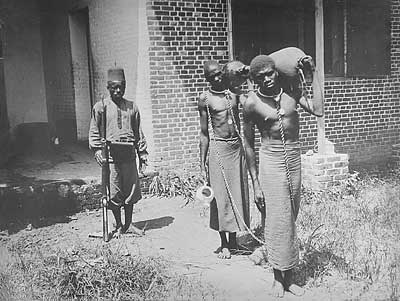
Section One
Central African Peoples through the Eyes of Western Photographers


From today's vantage point, these popular images celebrating what was perceived as "colonial achievement" reveal subtexts and meanings other than those intended by photographers and publishers or seen by viewers at the time. At the turn of the 20th century, pictures of ivory caravans and rubber production symbolized economic success; they now imply exploitation and harsh labor practices. An image of chained prisoners, then a metaphor for colonial control over defiant populations, now shows African resistance to often abusive practices and heavy punishment for minor infractions. Similarly, photographs of road and railroad construction have become testimony to forced labor rather than visual examples of what was seen as "progress."
Photography, the same medium that constructed a modern and alluring portrayal of central Africa under colonial domination, actually played a pivotal role in bringing down King Léopold's regime in the Congo Free State. In the late 19th century, photography, considered to be a truthful witness, had developed into a means of social documentation. Various humanitarian campaigns for social improvement recognized the visual image's potential to influence public opinion; photography became a tool used by activists to harness public support and improve working conditions. As the international protests against abuses in the Congo Free State grew, opponents successfully advanced their cause by distributing photographs of prisoners, harsh labor practices and mutilations that were punishment for African resistance to colonial rule.
Pictured above
Prisoners at work, Belgian Congo
Émile Gorlia (1887-1966)
c. 1912, silver gelatin print
Gift of Sanford M. and Nancy H. Harris
Eliot Elisofon Photographic Archives
National Museum of African Art
Smithsonian Institution
1977-0001-115
Judge Émile Gorlia relied on prisoners' help for household and yard maintenance.